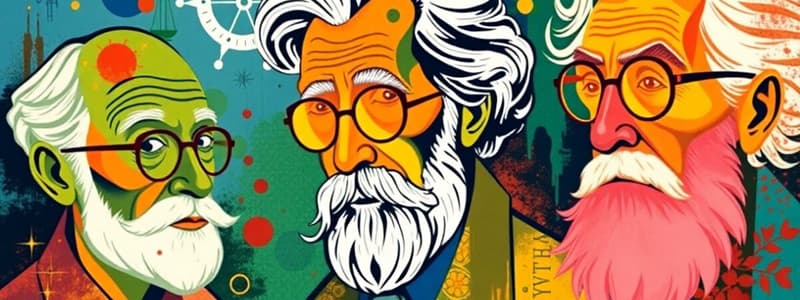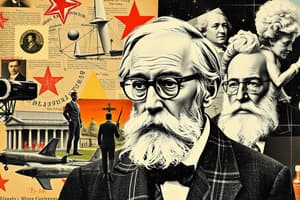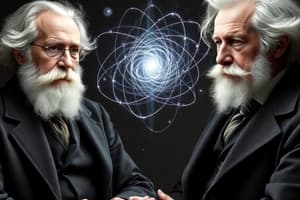Podcast
Questions and Answers
What was one significant contribution of Fred Hoyle to astrophysics?
What was one significant contribution of Fred Hoyle to astrophysics?
- He developed the concept of black holes.
- He postulated the creation of chemical elements through nuclear reactions in stars. (correct)
- He discovered a new type of star.
- He formulated the laws of planetary motion.
Which theory did Fred Hoyle predominantly support during his career?
Which theory did Fred Hoyle predominantly support during his career?
- The oscillating universe theory.
- The inflationary universe theory.
- The Big Crunch theory.
- The steady state theory. (correct)
What was a primary focus of Irene Uchida's research?
What was a primary focus of Irene Uchida's research?
- The role of genes and chromosomes in health and anomalies. (correct)
- The effects of radiation on space travel.
- Astrobiology and the origin of life.
- The calculation of orbital mechanics.
What landmark space mission did Katherine Johnson help plan?
What landmark space mission did Katherine Johnson help plan?
In what year did Katherine Johnson begin her work at NACA, the predecessor of NASA?
In what year did Katherine Johnson begin her work at NACA, the predecessor of NASA?
Which invention is Yvonne Brill known for in the context of satellite technology?
Which invention is Yvonne Brill known for in the context of satellite technology?
Which prominent program did Katherine Johnson work on after the Apollo missions?
Which prominent program did Katherine Johnson work on after the Apollo missions?
What notable achievement is Abdus Salam known for in the field of physics?
What notable achievement is Abdus Salam known for in the field of physics?
What significant discovery did Vera Rubin make about the motion of stars in spiral galaxies?
What significant discovery did Vera Rubin make about the motion of stars in spiral galaxies?
What was the purpose of the Large Hadron Collider (LHC) at CERN?
What was the purpose of the Large Hadron Collider (LHC) at CERN?
What did Eric Kandel demonstrate about memory storage in humans?
What did Eric Kandel demonstrate about memory storage in humans?
Mario Molina's research on CFCs led to significant environmental legislation. What did his research primarily focus on?
Mario Molina's research on CFCs led to significant environmental legislation. What did his research primarily focus on?
What did Lap-Chee Tsui contribute to the field of genetics?
What did Lap-Chee Tsui contribute to the field of genetics?
What was Mae Carol Jemison notable for in the field of space exploration?
What was Mae Carol Jemison notable for in the field of space exploration?
What notable technique did Donna Strickland develop in optical physics?
What notable technique did Donna Strickland develop in optical physics?
What does the Higgs field explain according to Peter Higgs' theory?
What does the Higgs field explain according to Peter Higgs' theory?
What kind of research did Carol Greider focus on with regard to telomeres?
What kind of research did Carol Greider focus on with regard to telomeres?
Which Nobel Prize did Vera Rubin receive for her work on galaxies?
Which Nobel Prize did Vera Rubin receive for her work on galaxies?
What critical role do synapses play according to Eric Kandel's findings?
What critical role do synapses play according to Eric Kandel's findings?
What outcome did the discoveries related to CFCs and the ozone layer achieve?
What outcome did the discoveries related to CFCs and the ozone layer achieve?
In viewing galaxy dynamics, what did Rubin's research on spiral galaxies imply regarding dark matter?
In viewing galaxy dynamics, what did Rubin's research on spiral galaxies imply regarding dark matter?
What is the primary characteristic of the Higgs boson as theorized by Higgs?
What is the primary characteristic of the Higgs boson as theorized by Higgs?
Flashcards
Fred Hoyle
Fred Hoyle
A British astrophysicist who made significant contributions to understanding the origin of elements in stars and the expansion of the universe. He proposed the steady state theory, which suggested that the universe maintains a constant density as it expands.
Steady State Theory
Steady State Theory
A cosmological model that proposes a universe with a constant density, where new matter is continuously created to maintain this density as the universe expands.
Big Bang
Big Bang
The prevailing cosmological model that describes the initial expansion of the universe from a very hot and dense state billions of years ago.
Irene Uchida
Irene Uchida
Signup and view all the flashcards
Down Syndrome
Down Syndrome
Signup and view all the flashcards
Katherine Johnson
Katherine Johnson
Signup and view all the flashcards
Yvonne Brill
Yvonne Brill
Signup and view all the flashcards
Abdus Salam
Abdus Salam
Signup and view all the flashcards
Electroweak Theory
Electroweak Theory
Signup and view all the flashcards
Messenger particles
Messenger particles
Signup and view all the flashcards
What did Vera Rubin discover about galaxies?
What did Vera Rubin discover about galaxies?
Signup and view all the flashcards
Dark Matter
Dark Matter
Signup and view all the flashcards
Higgs Field
Higgs Field
Signup and view all the flashcards
Higgs Boson
Higgs Boson
Signup and view all the flashcards
What is the significance of synapses in memory?
What is the significance of synapses in memory?
Signup and view all the flashcards
Sea slug
Sea slug
Signup and view all the flashcards
CFCs and Ozone
CFCs and Ozone
Signup and view all the flashcards
Cystic Fibrosis
Cystic Fibrosis
Signup and view all the flashcards
What was the significance of Mae Carol Jemison's spaceflight?
What was the significance of Mae Carol Jemison's spaceflight?
Signup and view all the flashcards
Chirped Pulse Amplification (CPA)
Chirped Pulse Amplification (CPA)
Signup and view all the flashcards
Telomeres
Telomeres
Signup and view all the flashcards
Telomerase
Telomerase
Signup and view all the flashcards
Study Notes
Scientists and Their Contributions
- Fred Hoyle (1915-2001): British astrophysicist, investigated the origin of elements in stars.
- Irene Uchida (1917-2013): Canadian medical geneticist, studied gene/chromosome effects on health and the impact of X-rays on chromosomes.
- Katherine Johnson (1918-): American mathematician, crucial calculations for space missions, including Apollo 11, began work at NACA (early NASA) in 1953.
- Yvonne Brill (1924-2013): Canadian, worked for Douglas Aircraft and NASA, invented a propulsion system for stationary spacecraft orbits, worked on thrusters, rocket designs, and Mars observer.
- Abdus Salam (1926-1996): Pakistani physicist, developed the electroweak theory, explaining the interaction between subatomic particles, and their unification with the electromagnetic force, which was later proven correct at CERN in 1973 and earned him a Nobel Prize in Physics (1979).
- Vera Rubin (1928-2016): American astronomer, discovered stars at the outer edge of galaxies move as quickly as those near the center proving the existence of dark matter; work influenced understanding of galactic dynamics.
- Peter Higgs (1929-): British physicist, developed the theory explaining the origin of particle masses through interaction with the Higgs field; predicted the Higgs boson, whose existence was later confirmed at CERN's LHC in 2012, which earned him the Nobel Prize in Physics in 1964.
- Eric Kandel (1929-): American neuroscientist, studied the cellular basis of behavior, focusing on synapses role in memory and learning. His work, based on studies of sea slugs, clarified short- and long-term memory processes. Winner of the Nobel Prize in Physiology or Medicine (2000).
- Mario Molina (1943-): Mexican chemist, demonstrated that CFCs damage the ozone layer; this work contributed to banning/limiting CFC use and earned him a Nobel Prize in Chemistry (1995).
- Lap-Chee Tsui (1950-): Canadian medical geneticist, helped determine the gene responsible for cystic fibrosis.
- Mae Jemison (1956-): First African-American woman in space, participated in space shuttle missions and bone cell research experiments.
- Donna Strickland (1959-): Canadian optical physicist, developed chirped pulse amplification (CPA) technique for producing extremely short and intense laser pulses, which earned her a Nobel Prize in Physics in 2018.
- Carol Greider (1961-): American molecular biologist, studied telomeres and telomerase and their role in cell lifespan and cancer. Aided in the discovery that inhibiting telomerase in cancer cells slows tumor growth and earned her a Nobel Prize in Physiology or Medicine, (2009).
Additional Concepts
- Extra chromosome: A condition where an individual has an extra chromosome in their cells (e.g., Down syndrome).
- Steady State Theory: A now-discredited theory in cosmology that posits the Universe maintains a constant average density as new matter is created while expanding.
- CERN: The European Organization for Nuclear Research.
- LHC: Large Hadron Collider (a large particle accelerator at CERN for high-energy particle physics).
- Higgs boson: A fundamental particle predicted by the Higgs theory; its discovery verified the theory describing the origin of particle mass and interactions.
- CFCs: Chlorofluorocarbon compounds, harmful to the ozone layer.
- Telomeres: DNA segments at the chromosome ends.
- Telomerase: An enzyme that maintains telomeres.
Studying That Suits You
Use AI to generate personalized quizzes and flashcards to suit your learning preferences.




